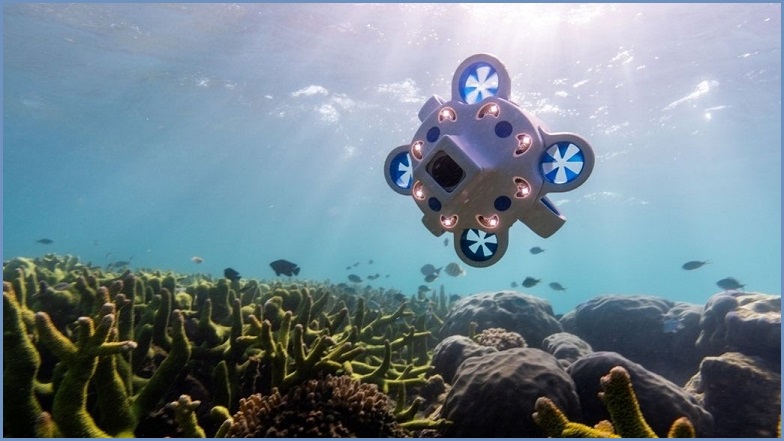A team of Australian robotics experts is fielding exploding demand for a portable, AI-driven underwater drone designed to make ocean exploration as accessible as quadcopter drones did for the skies.
The release of Hydrus, a specialised underwater robot small enough to be packed as carry-on luggage, marks a major milestone for Xavier Orr, a mechatronic engineer and robotics AI specialist who founded Sydney-based Advanced Navigation in late 2011.
Now employing around 100 people, Advanced Navigation’s AI-based inertial navigation systems leverage physics theories and data analytics techniques – explored in Orr’s University of Western Australia thesis – to precisely track movement in environments where external references like GPS are unavailable.
Whereas airborne drones use radiofrequency (RF) signals to carry high-resolution video and operator commands, water blocks RF transmission – making autonomous navigation, Orr told Information Age, “harder underwater than it is in space”.
Existing remotely operated vehicles (ROVs) – used for open-ocean mapping, industrial inspections, fishery monitoring and other applications – transmit power, video and control signals across kilometres-long cables that tether them to a supporting ship.
But cable-free autonomous underwater vehicles (AUVs) – like the ones used last year to find and categorise hazardous waste barrels or travel into a Category 4 hurricane – are typically programmed before launch, then travel to a pre-programmed pickup point before surfacing for collection.
Hydrus can either run pre-programmed missions or, using specialised sonar technology, communicate with operators that direct its activities from the surface.
Sonar “is the only way to communicate underwater, and it’s where we started on the program 10 years ago,” Orr said, adding that it took over four years to refine the sonar communications system to enable reliable drone control.
“It’s the backbone of Hydrus and the core technology that makes it what it is,” he said – adding that acoustic modem speeds “like dial-up Internet” forced a range of design compromises, such as transmitting basic wireframe images “like a 1980s video game” rather than live-streaming the 4K video it records.
The $55,000 Hydrus – which can dive as deep as 3km and operate for up to 3 hours on a single charge – incorporates AI machine-vision techniques to analyse what its high-resolution cameras are seeing.
It can follow and record an object like a SCUBA diver or a shark, for example; automatically count objects such as fish, starfish; or identify seafloor features and objects such as garbage, shipwrecks and even, potentially, lost airplanes.
Just as an airborne drone subtly adjusts its position to compensate for wind gusts, fuzzy-logic systems register pressure from ocean currents and compensate to maintain the unit’s position.
To infinity… and below
With a reported $21m in annual revenues, Advanced Navigation’s products were recognised in the recent Australian Space Awards 2022 and have been integrated into defence and space projects – it counts Tesla, Boeing, Lockheed Martin, Fugro, and NASA Jet Propulsion Labs among its customers.
The release of Hydrus marks the fulfilment of a long-held dream to leverage the same techniques to make the ocean more accessible – and early sales, Orr said, point to “a very big hit”.
There have been contacts from superyacht operators that see it as the latest must-have elite water toy, while its portability and low cost have attracted the interest of philanthropic organisations like Minderoo Foundation which is already using Hydrus to monitor WA’s Ningaloo Reef.
“It’s a whole different thing” from conventional UAVs that “need a $4m ship and 12 crew to operate”, Orr notes. “You can throw this unit over the side of a tinny, and it will go away and do its mission and you scoop it up with a fishing net.”
Yet the future for Hydrus is about more than counting clownfish: with countries like China seeing deep-sea mining as a new land grab, some believe undersea environments will become a new theatre for warfare and global conflict.
Dominating the sea bed will require technologies capable of operating easily within the ocean’s difficult environs, and many envision fleets of autonomous drones patrolling and mapping uncharted areas of the ocean.
“Most researchers use [commercial ships] to collect valuable data, but the ships mostly travel in certain commercial sea corridors, leaving vast ocean areas unstudied,” said Ruth Patterson, an oceanographer and Charles Darwin University PhD candidate studying the idea of roving, autonomous vehicles.
“Using crewed ships is expensive, time consuming and dangerous during wild weather,” she said, noting that Northern Australia “is the perfect environment” for testing the technology.
But progress is still needed: “There are few [AUVs] on the market that are suitable for continuous voyage and capable of surviving rugged ocean conditions.”










